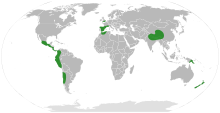
Alders are trees comprising the genus Alnus in the birch family Betulaceae. The genus comprises about 35 species of monoecious trees and shrubs, a few reaching a large size, distributed throughout the north temperate zone with a few species extending into Central America, as well as the northern and southern Andes.

The Cucurbitales are an order of flowering plants, included in the rosid group of dicotyledons. This order mostly belongs to tropical areas, with limited presence in subtropical and temperate regions. The order includes shrubs and trees, together with many herbs and climbers. One major characteristic of the Cucurbitales is the presence of unisexual flowers, mostly pentacyclic, with thick pointed petals. The pollination is usually performed by insects, but wind pollination is also present.
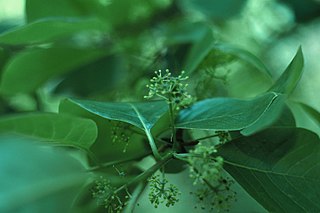
Tupelo, genus Nyssa, is a small genus of deciduous trees with alternate, simple leaves. It is sometimes included in the subfamily Nyssoideae of the dogwood family, Cornaceae, but is placed by other authorities in the family Nyssaceae. In the APG IV system, it is placed in Nyssaceae.

Saccharum is a genus of tall perennial plants of the broomsedge tribe within the grass family.

Ranunculales is an order of flowering plants. Of necessity it contains the family Ranunculaceae, the buttercup family, because the name of the order is based on the name of a genus in that family. Ranunculales belongs to a paraphyletic group known as the basal eudicots. It is the most basal clade in this group; in other words, it is sister to the remaining eudicots. Widely known members include poppies, barberries, hellebores, and buttercups.

Nothofagus, also known as the southern beeches, is a genus of 43 species of trees and shrubs native to the Southern Hemisphere in southern South America and east and southeast Australia, New Zealand, New Guinea, and New Caledonia. The species are ecological dominants in many temperate forests in these regions. Some species are reportedly naturalised in Germany and Great Britain. The genus has a rich fossil record of leaves, cupules, and pollen, with fossils extending into the late Cretaceous period and occurring in Australia, New Zealand, Antarctica, and South America.

The Restionaceae, also called restiads and restios, are a family of flowering plants native to the Southern Hemisphere; they vary from a few centimeters to 3 meters in height. Following the APG IV (2016): the family now includes the former families Anarthriaceae, Centrolepidaceae and Lyginiaceae, and as such includes 51 genera with 572 known species. Based on evidence from fossil pollen, the Restionaceae likely originated more than 65 million years ago during the Late Cretaceous period, when the southern continents were still part of Gondwana.
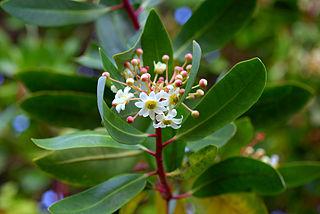
Winteraceae is a primitive family of tropical trees and shrubs including 93 species in five genera. It is of particular interest because it is such a primitive angiosperm family, distantly related to Magnoliaceae, though it has a much more southern distribution. Plants in this family grow mostly in the southern hemisphere, and have been found in tropical to temperate climate regions of Malesia, Oceania, eastern Australia, New Zealand, Madagascar and the Neotropics, with most of the genera concentrated in Australasia and Malesia. The five genera, Takhtajania, Tasmannia, Drimys, Pseudowintera, and Zygogynum s.l. all have distinct geographic extant populations. Takhtajania includes a single species, T. perrieri, endemic only to Madagascar, Tasmannia has the largest distribution of genera in Winteraceae with species across the Philippines, Borneo, New Guinea, Eastern Australia, and Tasmannia, Drimys is found in the Neotropical realm, from southern Mexico to the subarctic forests of southern South America, Pseudowintera is found only in New Zealand, and Zygogynum has species in New Guinea and New Caledonia.

Petrosaviaceae is a family of flowering plants belonging to a monotypic order, Petrosaviales. Petrosaviales are monocots, and are grouped within the lilioid monocots. Petrosaviales is a very small order composed of one family, two genera and four species accepted in 2016. Some species are photosynthetic (Japonolirion) and others are rare, leafless, chlorophyllous, mycoheterotrophic plants (Petrosavia). The family is found in low-light montane rainforests in Japan, China, Southeast Asia and Borneo. They are characterised by having bracteate racemes, pedicellate flowers, six persistent tepals, septal nectaries, three almost-distinct carpels, simultaneous microsporogenesis, monosulcate pollen, and follicular fruit.
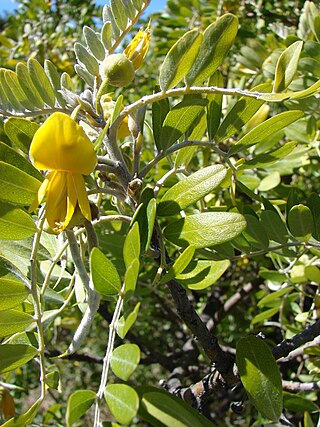
Sophora is a genus of about 45 species of small trees and shrubs in the pea family Fabaceae. The species have a pantropical distribution. The generic name is derived from sophera, an Arabic name for a pea-flowered tree.

Zosteraceae is a family of marine perennial flowering plants found in temperate and subtropical coastal waters, with the highest diversity located around Korea and Japan. Most seagrasses complete their entire life cycle under water, having filamentous pollen especially adapted to dispersion in an aquatic environment and ribbon-like leaves that lack stomata. Seagrasses are herbaceous and have prominent creeping rhizomes. A distinctive characteristic of the family is the presence of characteristic retinacules, which are present in all species except members of Zostera subgenus Zostera.

Coprosma is a genus of flowering plants in the family Rubiaceae. It is found in New Zealand, Hawaiian Islands, Borneo, Java, New Guinea, islands of the Pacific Ocean to Australia and the Juan Fernández Islands.

The Aponogetonaceae are a family of flowering plants in the order Alismatales.
Ctenolophon is the only genus in the flowering plant family Ctenolophonaceae. It has two recognized species:

The Cyrillaceae are a small family of flowering plants in the order Ericales, native to warm temperate to tropical regions of the Americas. The family comprises two genera, Cliftonia and Cyrilla, each containing a single species, Cliftonia monophylla and Cyrilla racemiflora. However, additional species of Cyrilla are now often recognized and the genus is in need of taxonomic revision.

Asteliaceae is a family of flowering plants, placed in the order Asparagales of the monocots.

Coriaria myrtifolia, called in English redoul, is a shrub that grows to 2–3 m tall. Myrtifolia means myrtle-like leaves.
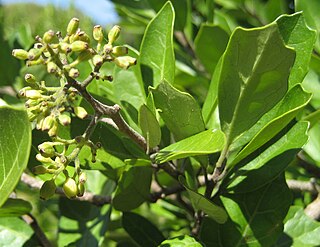
Pennantia is the sole genus in the plant family Pennantiaceae. In older classifications, it was placed in the family Icacinaceae. Most authorities have recognised three or four species, depending on whether they recognised Pennantia baylisiana as a separate species from Pennantia endlicheri. British-born botanist David Mabberley has recognised two species.

Lacandonia is a mycoheterotrophic plant that contains no chlorophyll and has the unusual characteristic of inverted positions of the male (androecium) and female (gynoecium) floral parts, something that had not been seen in any other plants, with the exceptions of Trithuria and on occasion the related Triuris brevistylis.

